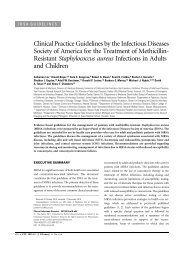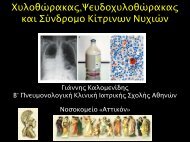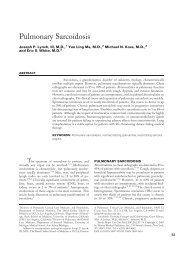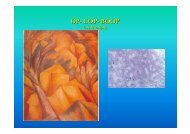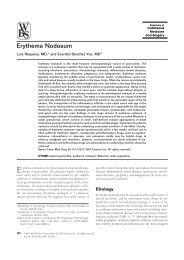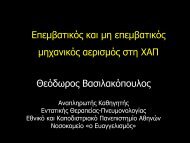Multicenter Evaluation of Bactec MGIT 960 System for Second-Line ...
Multicenter Evaluation of Bactec MGIT 960 System for Second-Line ...
Multicenter Evaluation of Bactec MGIT 960 System for Second-Line ...
You also want an ePaper? Increase the reach of your titles
YUMPU automatically turns print PDFs into web optimized ePapers that Google loves.
JOURNAL OF CLINICAL MICROBIOLOGY, Nov. 2009, p. 3630–3634 Vol. 47, No. 11<br />
0095-1137/09/$12.00 doi:10.1128/JCM.00803-09<br />
Copyright © 2009, American Society <strong>for</strong> Microbiology. All Rights Reserved.<br />
<strong>Multicenter</strong> <strong>Evaluation</strong> <strong>of</strong> <strong>Bactec</strong> <strong>MGIT</strong> <strong>960</strong> <strong>System</strong> <strong>for</strong> <strong>Second</strong>-<strong>Line</strong><br />
Drug Susceptibility Testing <strong>of</strong> Mycobacterium tuberculosis Complex <br />
S.-Y. Grace Lin, 1 * Edward Desmond, 1 Donald Bonato, 2 Wendy Gross, 2 and Salman Siddiqi 3<br />
Microbial Diseases Laboratory, DCDC, CID, Cali<strong>for</strong>nia Department <strong>of</strong> Public Health, Richmond, Cali<strong>for</strong>nia 1 ;<br />
Tuberculosis Reference Laboratory, Veterans Affairs Medical Center, West Haven, Connecticut 2 ; and<br />
Becton Dickinson Diagnostic <strong>System</strong>s, Sparks, Maryland 3<br />
Received 20 April 2009/Returned <strong>for</strong> modification 18 June 2009/Accepted 30 August 2009<br />
The <strong>Bactec</strong> <strong>MGIT</strong> <strong>960</strong> system <strong>for</strong> testing susceptibility to second-line drugs was evaluated with 117 clinical<br />
strains in a multicenter study. The four drugs studied were lev<strong>of</strong>loxacin, amikacin, capreomycin, and ethionamide.<br />
The critical concentration established <strong>for</strong> lev<strong>of</strong>loxacin and amikacin was 1.5 g/ml, that established<br />
<strong>for</strong> capreomycin was 3.0 g/ml, and that established <strong>for</strong> ethionamide was 5.0 g/ml. The overall level <strong>of</strong><br />
agreement between the agar proportion method and the <strong>MGIT</strong> <strong>960</strong> system was 96.4%, and the levels <strong>of</strong><br />
agreement <strong>for</strong> the individuals drugs were 99.1% <strong>for</strong> lev<strong>of</strong>loxacin, 100% <strong>for</strong> amikacin, 97.4% <strong>for</strong> capreomycin,<br />
and 88.9% <strong>for</strong> ethionamide. The rate <strong>of</strong> reproducibility <strong>of</strong> the drug susceptibility testing results between the<br />
participating laboratories was 99.5%.<br />
The increase in the incidence <strong>of</strong> multidrug-resistant tuberculosis<br />
(MDR TB) and the emergence <strong>of</strong> extensively drugresistant<br />
tuberculosis present tremendous challenges to the<br />
global ef<strong>for</strong>ts to combat tuberculosis (1, 5, 16, 21). Rapid methods<br />
enabling accurate susceptibility testing <strong>of</strong> first-line and<br />
second-line drugs are critical <strong>for</strong> the early diagnosis <strong>of</strong> MDR<br />
TB and extensively drug-resistant tuberculosis and the initiation<br />
<strong>of</strong> effective regimens. Various drug susceptibility testing<br />
(DST) methods that use solid media, including the agar proportion<br />
method (AP) and other methods, have the drawback <strong>of</strong><br />
prolonged turnaround times (TATs). The World Health Organization<br />
and the U.S. Centers <strong>for</strong> Disease Control and Prevention<br />
have recommended the use <strong>of</strong> liquid culture systems<br />
<strong>for</strong> the diagnosis <strong>of</strong> tuberculosis and DST to improve TATs<br />
(22, 25). The <strong>Bactec</strong> 460 (Becton Dickinson Diagnostic <strong>System</strong>s,<br />
Sparks, MD), a radiometric liquid system, provided an<br />
excellent alternative <strong>for</strong> testing <strong>of</strong> the susceptibilities <strong>of</strong> Mycobacterium<br />
tuberculosis complex (MTBC) isolates to streptomycin,<br />
isoniazid, rifampin (rifampicin), and ethambutol (SIRE)<br />
and to pyrazinamide (PZA) with improved TATs. The <strong>MGIT</strong><br />
<strong>960</strong> liquid, nonradiometric SIRE DST (Becton Dickinson Diagnostic<br />
<strong>System</strong>s), whose per<strong>for</strong>mance is comparable to that <strong>of</strong><br />
the <strong>Bactec</strong> 460 system, has been commercially available since<br />
April 2002 (4, 20, 23). The Microbial Diseases Laboratory<br />
(MDL) <strong>of</strong> the Cali<strong>for</strong>nia Department <strong>of</strong> Public Health implemented<br />
SIRE DST with the <strong>MGIT</strong> <strong>960</strong> system in 2004. With<br />
confidence in the SIRE DST with the <strong>MGIT</strong> <strong>960</strong> system, a<br />
study that used the same plat<strong>for</strong>m to test the susceptibilities <strong>of</strong><br />
MTBC isolates to four classes <strong>of</strong> second-line drugs, lev<strong>of</strong>loxacin<br />
(LVX), amikacin (AMK), capreomycin (CAP), and ethionamide<br />
(ETH), was initiated in November 2004. The study was<br />
conducted at two laboratories: MDL and the TB Reference<br />
* Corresponding author. Mailing address: Microbial Diseases Laboratory,<br />
CDPH, 850 Marina Bay Parkway, Richmond, CA 94804.<br />
Phone: (510) 412-3929. Fax: (510) 412-6099. E-mail: grace.lin@cdph<br />
.ca.gov.<br />
Published ahead <strong>of</strong> print on 9 September 2009.<br />
Laboratory <strong>of</strong> the Veteran Affairs Medical Center (VA) in<br />
West Haven, CT. Here we report the results <strong>of</strong> the multicenter<br />
study, in which the critical concentrations <strong>of</strong> the test drugs<br />
were established, the per<strong>for</strong>mance <strong>of</strong> the <strong>MGIT</strong> <strong>960</strong> system<br />
was compared to that <strong>of</strong> AP, and the interlaboratory reproducibility<br />
<strong>of</strong> the method was evaluated.<br />
(Part <strong>of</strong> this work was presented at the 46th Interscience<br />
Conference on Antimicrobial Agents and Chemotherapy,<br />
2006, San Francisco, CA.)<br />
MATERIALS AND METHODS<br />
Study design. This study consisted <strong>of</strong> five phases: phase I, determination <strong>of</strong><br />
the MIC <strong>of</strong> each drug <strong>for</strong> the susceptible control strain, Mycobacterium<br />
tuberculosis H37Rv (ATCC 27294); phase II, determination <strong>of</strong> the critical<br />
concentration <strong>of</strong> each drug; phase III, testing <strong>of</strong> clinical strains at the critical<br />
concentration <strong>of</strong> each drug determined in phase II; phase IV, study <strong>of</strong> interlaboratory<br />
reproducibility; and phase V, study <strong>of</strong> the reproducibility <strong>of</strong> the<br />
medium and reagents.<br />
Strains. A total <strong>of</strong> 117 clinical strains <strong>of</strong> MTBC, including 49 pansusceptible<br />
strains and 68 resistant strains whose drug susceptibility results were previously<br />
determined by AP, were tested. MDL contributed 89 strains (42 susceptible and<br />
47 resistant strains), and VA contributed 28 strains (7 susceptible and 21 resistant<br />
strains). At MDL, the pansusceptible strains were randomly chosen from<br />
cultures in which MTBC was isolated between 2003 and 2006. As <strong>for</strong> the resistant<br />
strains, we included as many strains from our archived collections as we could<br />
find, excluding those found to be nonviable or contaminated. Strains from VA<br />
were selected from cultures in which MTBC was isolated between 2002 and 2003<br />
to include as many resistant strains as possible, and susceptible strains from the<br />
same period were randomly chosen.<br />
Antimicrobial agents. AMK, CAP, and ETH were purchased from Sigma-<br />
Aldrich Corporation (St. Louis, MO); and LVX was provided by Johnson &<br />
Johnson Pharmaceutical Research & Development, L.L.C. (Spring House, PA).<br />
Each laboratory prepared drug solutions according to the protocol described<br />
below. The stock solutions <strong>of</strong> AMK (120 g/ml), CAP (75 g/ml), and LVX (120<br />
g/ml) were prepared in sterile water. All drug concentrations, including the<br />
concentrations in the stock solutions, the MICs, and the critical concentrations,<br />
are expressed as the final concentrations used in tests with the <strong>MGIT</strong> <strong>960</strong> system.<br />
These stock solutions were filtered through 0.22-m-pore-size Millex-GS filter<br />
units (Millipore, Bed<strong>for</strong>d, MA) and were stored at 20°C. The working solutions<br />
<strong>of</strong> AMK, CAP, and LVX were diluted from the stock solution, aliquoted, and<br />
frozen <strong>for</strong> future use. The stock solution <strong>of</strong> ETH (120 g/ml) was prepared in<br />
ethylene glycol (Spectrum Quality Products, Inc., Gardena, CA) and was incubated<br />
at 37°C overnight. It was then filtered through 0.22 m-pore-size Millex-GS<br />
filter units, aliquoted, and stored at 20°C. The working solution was<br />
Downloaded from jcm.asm.org at University <strong>of</strong> Liverpool Library on November 2, 2009<br />
3630
VOL. 47, 2009 TESTING SECOND-LINE DRUGS AGAINST MTBC WITH <strong>MGIT</strong> <strong>960</strong> 3631<br />
made fresh from the stock solution in sterile water <strong>for</strong> each test run. (After this<br />
study was completed, some aliquots <strong>of</strong> the ETH stock solution were found to<br />
contain ETH precipitates. Those precipitates did not readily dissolve at room<br />
temperature. Storage <strong>of</strong> the ETH stock solutions at 2 to 8°C and periodic testing<br />
<strong>of</strong> the MIC <strong>of</strong> ETH <strong>for</strong> the control strain is recommended. Our experience<br />
indicated that the MIC <strong>of</strong> ETH <strong>for</strong> the H37Rv control strain remained unchanged<br />
over a 2-year period.)<br />
Preinoculation preparation. The LVX, AMK, CAP, and ETH drug panel<br />
consisted <strong>of</strong> five <strong>MGIT</strong> tubes: one tube <strong>for</strong> the growth control and four tubes<br />
<strong>for</strong> the drugs (one <strong>for</strong> each drug). Preinoculation preparation included addition<br />
<strong>of</strong> 0.8 ml SIRE supplement to each <strong>MGIT</strong> tube and addition <strong>of</strong> 0.1 ml<br />
drug working solution to each designated <strong>MGIT</strong> <strong>960</strong> system tube. No drug<br />
was added to the growth control tube. The SIRE supplement containing oleic<br />
acid, albumin, dextrose, and catalase (OADC) is one <strong>of</strong> the components <strong>of</strong><br />
the SIRE drug kit (Becton Dickinson Diagnostic <strong>System</strong>s). The Middlebrook<br />
OADC enrichment from BBL (Becton Dickinson Diagnostic <strong>System</strong>s) is an<br />
alternative to the SIRE supplement. According to Becton Dickinson Diagnostic<br />
<strong>System</strong>s (personal communication), the two products are identical.<br />
Inoculum preparation. Inocula were prepared from cultures <strong>of</strong> all 117 strains<br />
grown in Lowenstein Jensen (LJ) slants. The cultures were 2 to 5 weeks old. The<br />
manufacturer’s protocol <strong>for</strong> the preparation <strong>of</strong> inocula from solid media <strong>for</strong> use<br />
in the SIRE DST was followed, with one exception: sterile normal saline instead<br />
<strong>of</strong> Middlebrook 7H9 broth or <strong>MGIT</strong> broth was used to prepare the cell suspensions<br />
and to adjust the turbidity <strong>of</strong> the suspension to a 0.5 McFarland standard.<br />
In addition, the procedure was further validated <strong>for</strong> the testing <strong>of</strong> positive <strong>MGIT</strong><br />
tubes. A subset <strong>of</strong> 23 strains was subcultured to <strong>MGIT</strong> tubes and tested after<br />
growth was detected by the <strong>MGIT</strong> <strong>960</strong> system. The inoculum prepared from<br />
<strong>MGIT</strong> tubes was also standardized to a 0.5 McFarland standard. Briefly, the<br />
growth at the bottom <strong>of</strong> a positive <strong>MGIT</strong> tube was transferred to a sterile tube<br />
containing 2 ml sterile normal saline and the components were gently mixed.<br />
Clumps were allowed to settle. The supernatant containing the homogeneous<br />
cell suspension was transferred to another sterile tube, and its turbidity was<br />
adjusted to a 0.5 McFarland standard. After the cell suspension was standardized,<br />
it was diluted 1:5 with sterile normal saline <strong>for</strong> inoculation into drugcontaining<br />
<strong>MGIT</strong> tubes. The 1:5 cell suspension was further diluted 100-fold with<br />
sterile normal saline <strong>for</strong> inoculation <strong>of</strong> the growth control tube. The volume <strong>of</strong><br />
each inoculum was 0.5 ml.<br />
Determination <strong>of</strong> the MIC <strong>of</strong> each drug <strong>for</strong> H37Rv. On the basis <strong>of</strong> our<br />
experiences with the <strong>Bactec</strong> 460 system, three concentrations <strong>of</strong> each drug were<br />
chosen <strong>for</strong> testing. These were 0.25, 0.5, and 1.0 g/ml <strong>for</strong> AMK, LVX, and ETH<br />
and 0.5, 1, and 1.5 g/ml <strong>for</strong> CAP. Three experiments were per<strong>for</strong>med at each<br />
laboratory, and the results obtained from the two laboratories were compared. This<br />
was designed to confirm that the drug concentrations prepared at each laboratory<br />
were accurate and that the test procedures were properly followed. This was a critical<br />
step in the establishment <strong>of</strong> a sound basis <strong>for</strong> a multicenter study.<br />
Determination <strong>of</strong> critical concentration <strong>for</strong> each drug. Determination <strong>of</strong> the<br />
critical concentration <strong>for</strong> each drug was done at MDL. A subset <strong>of</strong> 29 strains<br />
from the 117-strain pool, including 8 pansusceptible strains and 21 resistant<br />
strains with various drug susceptibility pr<strong>of</strong>iles (15 strains resistant to AMK and<br />
CAP, 13 resistant to ETH, and 10 resistant to LVX), were studied. An additional<br />
four quinolone-resistant strains with known gyrA mutations, obtained from B.<br />
Kreiswirth at the Public Health Research Institute Tuberculosis Center (Newark,<br />
NJ), were tested only <strong>for</strong> their susceptibilities to LVX. By testing both susceptible<br />
and resistant strains, this phase was designed to determine the critical<br />
concentration <strong>for</strong> each drug that could best distinguish the susceptible group<br />
from the resistant group. Three concentrations were tested <strong>for</strong> each drug. AMK<br />
and LVX were tested at 1, 1.5, and 2 g/ml; CAP was tested at 2, 3, and 4 g/ml;<br />
and ETH was tested at 3, 4, and 5 g/ml.<br />
Testing <strong>of</strong> additional clinical strains at the critical concentration <strong>of</strong> each drug.<br />
After determination <strong>of</strong> the critical concentrations, an additional 88 clinical<br />
strains (41 susceptible and 47 resistant strains) were tested to further establish<br />
that the critical concentrations would correctly discriminate susceptible and<br />
resistant strains on a larger scale. MDL tested 60 strains, and VA tested 28<br />
strains.<br />
Study <strong>for</strong> reproducibility between laboratories. A total <strong>of</strong> 48 strains from the<br />
study pool (28 strains submitted by VA to MDL and 20 strains submitted by<br />
MDL to VA) were tested at the critical concentrations at both laboratories. Of<br />
the 48 strains, 17 were pansusceptible strains and 31 were resistant strains with<br />
various drug susceptibility pr<strong>of</strong>iles. Two sets <strong>of</strong> 192 data points were compared to<br />
determine the reproducibility between the two laboratories.<br />
Study <strong>of</strong> reagent lot-to-lot reproducibility. A subset <strong>of</strong> six strains from the<br />
study pool (three susceptible strains and three resistant strains) were tested at<br />
the critical concentrations with three lots <strong>of</strong> <strong>MGIT</strong> medium and three lots <strong>of</strong><br />
SIRE supplement in three different test runs at MDL. Cell suspensions were<br />
prepared fresh <strong>for</strong> each test run. Three sets <strong>of</strong> 24 data points were analyzed to<br />
determine the reagent reproducibility.<br />
QC. A strain <strong>of</strong> Mycobacterium tuberculosis, H37Rv (ATCC 27294), was used<br />
as a quality control (QC) strain and was tested with each batch <strong>of</strong> DST at the<br />
critical concentration <strong>of</strong> each drug. This QC strain is pansusceptible to the four<br />
drugs tested in the present study. If the QC strain did not yield the expected<br />
results, the test with that batch had to be repeated.<br />
Reference methods and discrepancy resolution. AP was the primary reference<br />
method <strong>for</strong> this study. All strains were previously tested by AP with<br />
AMK at 2 g/ml (strains from VA were tested at 6 g/ml), CAP at 10 g/ml,<br />
ETH at 5 g/ml, and OFX at 2 g/ml. LVX is the L <strong>for</strong>m <strong>of</strong> OFX. In addition<br />
to using the results obtained by AP with OFX as a reference, we also tested<br />
LVX at 2 g/ml with the <strong>Bactec</strong> 460 system (19). For the resolution <strong>of</strong><br />
discrepancies, DST was repeated at VA by AP and at MDL with the <strong>MGIT</strong><br />
<strong>960</strong> and <strong>Bactec</strong> 460 systems. In tests with the <strong>Bactec</strong> 460 system, the test<br />
concentrations were 1 g/ml <strong>for</strong> AMK, 1.25 g/ml <strong>for</strong> CAP, 2.5 g/ml <strong>for</strong><br />
ETH, and 2 g/ml <strong>for</strong> LVX.<br />
RESULTS<br />
Interpretation <strong>of</strong> results. The <strong>MGIT</strong> <strong>960</strong> system supports<br />
the testing <strong>of</strong> various combinations <strong>of</strong> SIRE and PZA panels<br />
configured by the manufacturer, but second-line drug panels<br />
are not available. Testing <strong>of</strong> second-line drugs must be registered<br />
in the <strong>MGIT</strong> <strong>960</strong> system as one <strong>of</strong> the SIRE panels, and<br />
the user manually enters the drug identification on the printout<br />
<strong>of</strong> the results. The <strong>MGIT</strong> <strong>960</strong> system flags the completion <strong>of</strong> a<br />
DST when the growth unit (GU) <strong>of</strong> the growth control reaches<br />
400 and reports S <strong>for</strong> susceptible or R <strong>for</strong> resistant, as well as<br />
a GU value <strong>for</strong> each drug-containing <strong>MGIT</strong> tube on the printout.<br />
An isolate is interpreted to be susceptible when the GU <strong>of</strong><br />
a drug-containing <strong>MGIT</strong> tube is equal to or less than 100 or as<br />
resistant when the GU is greater than 100. If an isolate was<br />
interpreted to be resistant, a smear was made and stained to<br />
prove the presence <strong>of</strong> acid-fast bacilli (AFB) with morphology<br />
compatible with that <strong>of</strong> MTBC and the absence <strong>of</strong> contaminants.<br />
MIC <strong>of</strong> each drug <strong>for</strong> H37Rv (ATCC 27294). The results<br />
obtained at both participating laboratories demonstrated<br />
100% reproducibility in the three runs per<strong>for</strong>med at each laboratory.<br />
The MIC results <strong>for</strong> AMK, LVX, and ETH obtained<br />
at VA and MDL were the same (0.5 g/ml <strong>for</strong> the three drugs),<br />
but the MIC <strong>of</strong> CAP was slightly lower at VA (1.0 g/ml at VA<br />
and 1.5 g/ml at MDL). To resolve this discrepancy, CAP was<br />
tested with an additional concentration <strong>of</strong> 1.25 g/ml at MDL,<br />
and the MIC <strong>of</strong> CAP was determined to be 1.25 g/ml three <strong>of</strong><br />
three times. Thus, the difference in the MIC <strong>for</strong> CAP at MDL<br />
and VA was minimal and acceptable.<br />
Critical concentration <strong>of</strong> each drug. The critical concentration<br />
<strong>of</strong> each drug established by this study is shown in Fig. 1. To<br />
yield the best discrimination between susceptible and resistant<br />
strains, the critical concentrations were determined to be 1.5<br />
g/ml <strong>for</strong> AMK and LVX, 3.0 g/ml <strong>for</strong> CAP, and 5.0 g/ml<br />
<strong>for</strong> ETH. Determination <strong>of</strong> the critical concentrations <strong>for</strong><br />
AMK, LVX, and CAP was straight<strong>for</strong>ward, since we were able<br />
to decide on a concentration at which 100% <strong>of</strong> the resistant<br />
strains grew in the presence <strong>of</strong> the drug and 100% <strong>of</strong> the<br />
susceptible strains were inhibited. For ETH, the critical concentration<br />
was set at 5.0 g/ml to yield the best discrimination<br />
between susceptible and resistant strains, yet 3 strains with<br />
discordant results were found among the 29 strains tested,<br />
which yielded a 90% (26/29) correlation between the results<br />
Downloaded from jcm.asm.org at University <strong>of</strong> Liverpool Library on November 2, 2009
3632 LIN ET AL. J. CLIN. MICROBIOL.<br />
FIG. 1. MIC <strong>of</strong> each drug determined by use <strong>of</strong> the <strong>MGIT</strong> <strong>960</strong> system with strains that tested susceptible (S) or resistant (R) by AP.<br />
obtained with the <strong>MGIT</strong> <strong>960</strong> system and by AP. Twelve <strong>of</strong> 13<br />
(92.3%) resistant strains yielded resistant results, and 14 <strong>of</strong> 16<br />
(87.5%) susceptible strains yielded susceptible results. Among<br />
the three discrepancies, one strain, which tested resistant by<br />
AP but susceptible by <strong>MGIT</strong> <strong>960</strong>, had a MIC <strong>of</strong> 4.0 g/ml by<br />
<strong>MGIT</strong> <strong>960</strong>, and two strains, which tested susceptible by AP but<br />
resistant by <strong>MGIT</strong> <strong>960</strong>, had MICs greater than 5.0 g/ml (the<br />
MIC <strong>for</strong> one strain was 8.0 g/ml and the MIC <strong>for</strong> the other<br />
one was greater than 10 g/ml) by <strong>MGIT</strong> <strong>960</strong>.<br />
Overall agreement. The overall agreement between the results<br />
obtained with <strong>MGIT</strong> <strong>960</strong> and by AP was 96.4% (451/468),<br />
and a comparison <strong>of</strong> the results between the two methods after<br />
discrepancy resolution is shown in Table 1. For AMK, there<br />
was 100% agreement. For CAP and LVX, a total <strong>of</strong> four<br />
discrepancies were detected, but the results obtained with<br />
<strong>Bactec</strong> 460 were in concordance with those obtained with the<br />
<strong>MGIT</strong> <strong>960</strong> system. For ETH, there were 13 discrepancies. Two<br />
strains (designated group A) tested resistant by AP but susceptible<br />
by <strong>MGIT</strong> <strong>960</strong>, and 11 strains (designated group B)<br />
TABLE 1. Comparison <strong>of</strong> results obtained by use <strong>of</strong> <strong>MGIT</strong> <strong>960</strong><br />
and AP a<br />
Drug<br />
No. <strong>of</strong> strains with indicated<br />
results by AP/<strong>MGIT</strong> <strong>960</strong> b<br />
Agreement<br />
Discrepancy<br />
R/R S/S R/S S/R<br />
Overall agreement c<br />
LVX 28 88 0 1 d 99.1 (116/117)<br />
AMK 37 80 0 0 100 (117/117)<br />
CAP 35 79 0 3 d 97.4 (114/117)<br />
ETH 43 61 2 e 11 f 88.9 (104/117) g<br />
a A total <strong>of</strong> 117 strains were tested.<br />
b R, resistant; S, susceptible.<br />
c The data represent percent agreement (number <strong>of</strong> strains with the correct<br />
result/total number <strong>of</strong> strains tested).<br />
d Tested resistant with the <strong>Bactec</strong> 460 system.<br />
e One <strong>of</strong> two strains tested susceptible with the <strong>Bactec</strong> 460 system.<br />
f Ten <strong>of</strong> 11 strains tested resistant with the <strong>Bactec</strong> 460 system.<br />
g The results obtained with the <strong>MGIT</strong> <strong>960</strong> and <strong>Bactec</strong> 460 systems were<br />
concordant <strong>for</strong> 11 <strong>of</strong> 13 discrepancies.<br />
tested susceptible by AP but resistant by <strong>MGIT</strong> <strong>960</strong>. Both<br />
strains in group A demonstrated pinpoint colonies on the<br />
ETH-containing quadrant on Middlebrook 7H10 plates by AP.<br />
It indicated some degree <strong>of</strong> inhibition by the drug, although<br />
the test result was interpreted to be resistant. One <strong>of</strong> these two<br />
strains tested susceptible by <strong>Bactec</strong> 460; the other strain tested<br />
equivocal (in one test it was susceptible and in the other test it<br />
was resistant and had a low increase in the growth index). Ten<br />
<strong>of</strong> the 11 strains in group B tested resistant and 1 tested<br />
susceptible by <strong>Bactec</strong> 460. The overall rate <strong>of</strong> agreement was<br />
88.9% (104/117) between AP and <strong>MGIT</strong> <strong>960</strong>; however, the<br />
results <strong>for</strong> 11 <strong>of</strong> the 13 strains with discrepancies were in<br />
concordance between the <strong>Bactec</strong> 460 and <strong>MGIT</strong> <strong>960</strong> systems.<br />
Interlaboratory reproducibility. A subset <strong>of</strong> 48 strains from<br />
the study pool was tested at both laboratories. The interlaboratory<br />
reproducibility study was analyzed on the basis <strong>of</strong> the<br />
results <strong>of</strong> first-shot testing at each laboratory. One discrepancy<br />
was found between the two sets <strong>of</strong> 192 test results, which<br />
yielded an overall reproducibility <strong>of</strong> 99.5% (191/192) (Table 2).<br />
No discrepancies were found <strong>for</strong> LVX, AMK, and ETH, which<br />
yielded 100% reproducibility <strong>for</strong> each <strong>of</strong> the three drugs. The<br />
only discrepancy occurred with CAP. The particular strain with<br />
the discrepancy tested susceptible at VA but resistant at MDL<br />
and had a GU <strong>of</strong> 177. Upon retesting at MDL, this strain<br />
tested susceptible and had a GU <strong>of</strong> 6, but substantial growth in<br />
the <strong>MGIT</strong> tube was observed, which indicated the presence <strong>of</strong><br />
resistant populations.<br />
Reproducibility <strong>of</strong> reagents. Three lots <strong>of</strong> <strong>MGIT</strong> medium<br />
and three lots <strong>of</strong> SIRE supplement were tested with three<br />
susceptible strains and three resistant strains. A total <strong>of</strong> 72 data<br />
points were generated, and 100% reproducibility was realized.<br />
The duration <strong>for</strong> the completion <strong>of</strong> a DST in the <strong>MGIT</strong> <strong>960</strong><br />
system is called “time in protocol” (TIP) by the manufacturer.<br />
The average TIPs <strong>for</strong> the three sets <strong>of</strong> tests were 8 days and<br />
9.2 h, 8 days and 15.4 h, and 8 days and 8.3 h. The <strong>MGIT</strong> <strong>960</strong><br />
system demonstrated excellent reproducibility with different<br />
lots <strong>of</strong> <strong>MGIT</strong> medium and growth supplement.<br />
Downloaded from jcm.asm.org at University <strong>of</strong> Liverpool Library on November 2, 2009
VOL. 47, 2009 TESTING SECOND-LINE DRUGS AGAINST MTBC WITH <strong>MGIT</strong> <strong>960</strong> 3633<br />
Result at<br />
VA<br />
TABLE 2. Results <strong>of</strong> interlaboratory reproducibility a<br />
No. <strong>of</strong> strains with indicated result <strong>for</strong><br />
drug at MDL b<br />
LVX AMK CAP ETH<br />
S R S R S R S R<br />
S 33 0 29 0 29 1 25 0<br />
R 0 15 0 19 0 18 0 23<br />
a S, susceptible; R, resistant.<br />
b The overall agreement was 99.5% (191/192 strains); and the levels <strong>of</strong> agreement<br />
<strong>for</strong> the individuals drugs were 100% (48/48 strains) <strong>for</strong> LVX, 100% (48/48<br />
strains) <strong>for</strong> AMK, 98% (47/48 strains) <strong>for</strong> CAP, and 100% (48/48 strains)<br />
<strong>for</strong> ETH.<br />
Inoculum source: growth from LJ slants versus that from<br />
<strong>MGIT</strong> medium. Inocula were prepared from 23 seeded <strong>MGIT</strong><br />
tubes (which included 8 pansusceptible strains and 15 resistant<br />
strains with various drug susceptibility pr<strong>of</strong>iles), and the results<br />
were compared with those prepared from the LJ slants. There<br />
was a 100% reproducibility in the results between the inocula<br />
prepared from <strong>MGIT</strong> tubes and LJ slants. The reproducibility<br />
was excellent, which may be due to the use <strong>of</strong> homogeneous<br />
cell suspensions and standardization <strong>of</strong> the inocula, regardless<br />
<strong>of</strong> the source <strong>of</strong> growth.<br />
DISCUSSION<br />
Use <strong>of</strong> the <strong>Bactec</strong> 460 system to test <strong>for</strong> susceptibility to the<br />
primary drugs SIRE and PZA has been cleared by the U.S.<br />
Food and Drug Administration (FDA). It has been standardized<br />
and widely used, and its per<strong>for</strong>mance has been considered<br />
a reference standard. Although use <strong>of</strong> the <strong>Bactec</strong> 460 system<br />
<strong>for</strong> DST <strong>of</strong> second-line drugs has been studied and used by<br />
some laboratories (15), FDA has not approved it <strong>for</strong> use with<br />
those drugs. Many laboratories still use AP to per<strong>for</strong>m testing<br />
<strong>for</strong> susceptibility to second-line drugs. There<strong>for</strong>e, we used AP<br />
as the primary reference method <strong>for</strong> validation <strong>of</strong> the DST<br />
with second-line drugs with the <strong>MGIT</strong> <strong>960</strong> system.<br />
The basis <strong>for</strong> this study was, first, the establishment <strong>of</strong> comparable<br />
MICs <strong>of</strong> each drug <strong>for</strong> the control strain, H37Rv<br />
(ATCC 27294), at both laboratories. The MIC study, which<br />
demonstrated excellent interlaboratory agreement, provided a<br />
sound basis and confidence <strong>for</strong> the remainder <strong>of</strong> the study.<br />
<strong>Second</strong>, in the process <strong>of</strong> determining the critical concentration<br />
<strong>for</strong> each drug, we did not take the traditional tw<strong>of</strong>old<br />
dilution approach, which was used in two previous studies (9,<br />
18). Instead, we tested additional drug concentrations within<br />
tw<strong>of</strong>old dilutions. This fine-tuning approach enabled us to select<br />
a drug concentration that could better discriminate susceptible<br />
and resistant strains.<br />
The overall levels <strong>of</strong> agreement between the results obtained<br />
by AP and with <strong>MGIT</strong> <strong>960</strong> were excellent <strong>for</strong> AMK, CAP, and<br />
LVX, which were 100%, 97.4%, and 99.1%, respectively. However,<br />
the agreement <strong>for</strong> ETH was only 88.9%. This level <strong>of</strong><br />
correlation between the results obtained by use <strong>of</strong> <strong>MGIT</strong> <strong>960</strong><br />
and AP <strong>for</strong> ETH was also demonstrated in a study conducted<br />
by Martin et al. (12). The results obtained <strong>for</strong> ETH revealed a<br />
problematic aspect <strong>of</strong> the DST with ETH. In our opinion, to<br />
validate a new method, when the correlation between the new<br />
method and the reference method is greater than 95%, it<br />
provides a relatively high degree <strong>of</strong> confidence in the applicability<br />
<strong>of</strong> the new method. However, we were unable to find a<br />
critical concentration that could yield greater than 95% discrimination<br />
between susceptible strains and resistant strains<br />
when AP was used as the “gold standard” <strong>for</strong> DST with ETH.<br />
Lef<strong>for</strong>d and Mitchison (10) conducted a study and found that<br />
the MIC distributions <strong>of</strong> ETH between probable susceptible<br />
strains (specimens obtained from patients be<strong>for</strong>e treatment)<br />
and probable resistant strains (specimens obtained after treatment<br />
with ETH) were not well separated. In the process <strong>of</strong><br />
resolving the discrepancies <strong>for</strong> ETH, we tested the MICs <strong>for</strong><br />
the 11 strains which tested resistant by <strong>MGIT</strong> <strong>960</strong> but susceptible<br />
by AP. We found that 7 <strong>of</strong> the 11 strains had MICs greater<br />
than 10 g/ml, 3 strains had MICs <strong>of</strong> 10 g/ml, and 1 strain had<br />
an MIC <strong>of</strong> 8 g/ml. These MICs were much higher than the<br />
critical concentration (5 g/ml) established in this study, and<br />
we inferred that the discrepancies were unlikely to be resolved<br />
by choosing a higher drug concentration as the critical concentration.<br />
To prove this, we retested all ETH-resistant strains at<br />
6, 8, and 10 g/ml, and we found that 6 <strong>of</strong> the 43 resistant<br />
strains became susceptible at 6 g/ml and that 15 strains became<br />
susceptible at 10 g/ml. Thus, none <strong>of</strong> the higher concentrations<br />
would generate a better correlation. Furthermore,<br />
we also used the <strong>Bactec</strong> 460 system to evaluate the strains with<br />
discrepancies, and we found that the results between the<br />
<strong>MGIT</strong> <strong>960</strong> and <strong>Bactec</strong> 460 systems were in concordance <strong>for</strong> 11<br />
<strong>of</strong> 13 strains. The better correlation between the <strong>MGIT</strong> <strong>960</strong><br />
and the <strong>Bactec</strong> 460 systems shown in our study was also demonstrated<br />
in studies conducted by Rodrigues et al. (17) and<br />
Rusch-Gerdes et al. (18). These results may indicate that the<br />
causes <strong>of</strong> the discrepancies <strong>for</strong> ETH were perhaps attributable<br />
more to methodology differences than to the selection <strong>of</strong> the<br />
critical concentration.<br />
The overall reproducibility studied in phase IV was excellent.<br />
We found only one discrepant result with CAP. For the<br />
particular strain with that result, MDL not only could not<br />
reproduce the result from VA but also could not reproduce its<br />
own result when the strain was retested. Poor reproducibility<br />
may be expected when a strain has an MIC that is at or very<br />
close to the critical concentration (8, 24). As shown in this<br />
study, this strain initially tested resistant at MDL and had a<br />
GU <strong>of</strong> 177, but it was susceptible on retesting and had a GU <strong>of</strong><br />
6. The cut<strong>of</strong>f <strong>for</strong> resistance is a GU <strong>of</strong> 100. The first result was<br />
interpreted to be resistant, and the second result was interpreted<br />
to be susceptible. How to interpret such results presents<br />
a challenge. Although the majority <strong>of</strong> drug tests had GU values<br />
<strong>of</strong> 0 <strong>for</strong> susceptibility and 400 <strong>for</strong> resistance, 2.7% (13/468) <strong>of</strong><br />
the tests in this study yielded GU values between 1 and 399. It<br />
may be advisable to designate a borderline category <strong>for</strong> the<br />
interpretation <strong>of</strong> results that fall in this range. We believe that<br />
it is more reliable to report a borderline result as “borderline”<br />
than “susceptible” or “resistant” by chance. However, establishment<br />
<strong>of</strong> the precise definition <strong>of</strong> “borderline” is beyond the<br />
scope <strong>of</strong> this study.<br />
The <strong>MGIT</strong> <strong>960</strong> system DST report contains a TIP with two<br />
figures (days and hours) <strong>for</strong> each DST panel tested. The average<br />
TIP was 8 days and 6 h at MDL and 9 days and 8 h at VA.<br />
We were not aware <strong>of</strong> the TIP difference when the MIC study<br />
was conducted in phase I. Although it did not seem to affect<br />
the results, it would have been better if the TIP issue had been<br />
Downloaded from jcm.asm.org at University <strong>of</strong> Liverpool Library on November 2, 2009
3634 LIN ET AL. J. CLIN. MICROBIOL.<br />
addressed at the beginning <strong>of</strong> the study. An ideal DST protocol<br />
would be one that can generate accurate results with the shortest<br />
TIP. This study used a 1:5 dilution <strong>of</strong> the cell suspension<br />
equivalent to a 0.5 McFarland standard as an inoculum. A<br />
future study is required to find the optimal cell concentration,<br />
which could shorten the average TIP yet still produce accurate<br />
results.<br />
As a routine practice, only primary drugs are tested initially.<br />
When strains test resistant to rifampin or any two <strong>of</strong> the primary<br />
drugs, second-line drugs are then tested. When resistance<br />
to primary drugs is detected, the growth on LJ slants is usually<br />
adequate <strong>for</strong> the testing <strong>of</strong> second-line drugs. In this study, we<br />
used the growth from LJ slants as the main source <strong>for</strong> the<br />
inoculum preparation. With advances in molecular technologies,<br />
isoniazid and/or rifampin resistance can be detected by<br />
rapid methods, such as those that use molecular beacons, line<br />
probes, or microchips (2, 3, 6, 7, 11, 13). Once rifampin resistance<br />
or MDR TB is detected, testing <strong>for</strong> susceptibility to<br />
second-line drugs should be per<strong>for</strong>med along with testing <strong>for</strong><br />
susceptibility to first-line drugs as early as possible, and testing<br />
should not wait <strong>for</strong> growth from LJ slants. There<strong>for</strong>e, we included<br />
a subset <strong>of</strong> 23 specimens <strong>for</strong> validation <strong>of</strong> this assay<br />
using inocula prepared from positive <strong>MGIT</strong> tubes. Our protocol<br />
prepares inocula from <strong>MGIT</strong> tubes by standardization <strong>of</strong><br />
the growth to a 0.5 McFarland standard, as is done <strong>for</strong> LJ<br />
slants. DST can be per<strong>for</strong>med from a primary <strong>MGIT</strong> tube and<br />
not subject to the manufacturer’s time schedule, as stated in<br />
the package insert <strong>for</strong> SIRE DST. This has two advantages: the<br />
inoculum does not contain coarse clumps, which helps to produce<br />
more consistent results, and it does not require seeding <strong>of</strong><br />
a <strong>MGIT</strong> tube and waiting <strong>for</strong> its growth <strong>for</strong> DST, thus improving<br />
the TAT and reducing the cost <strong>for</strong> medium.<br />
This study presents a DST protocol that uses a homogeneous,<br />
standardized cell suspension to prepare the inoculum<br />
regardless <strong>of</strong> the source <strong>of</strong> growth: solid or liquid medium. The<br />
verification data were good, and the reproducibilities <strong>for</strong> interlaboratory<br />
test results, different lots <strong>of</strong> reagents, and different<br />
sources <strong>of</strong> inocula were excellent. This study and previous<br />
studies (9, 17, 18), regardless <strong>of</strong> the reference methods used,<br />
provided data that may be used to demonstrate that DST with<br />
the <strong>MGIT</strong> <strong>960</strong> system is a reliable method <strong>for</strong> the testing <strong>of</strong><br />
second-line drugs.<br />
ACKNOWLEDGMENTS<br />
We thank Becton Dickinson <strong>for</strong> providing the <strong>MGIT</strong> tubes, SIRE<br />
supplements, and <strong>Bactec</strong> 12B vials and Johnson & Johnson Pharmaceutical<br />
Research & Development, L.L.C., <strong>for</strong> providing LVX. We<br />
also thank Beverly Metchock at CDC <strong>for</strong> assistance with per<strong>for</strong>ming<br />
DST by AP <strong>for</strong> several strains with discrepancies.<br />
REFERENCES<br />
1. Banerjee, R., G. F. Schecter, J. Flood, and T. C. Porco. 2008. Extensively<br />
drug-resistant tuberculosis: new strains, new challenges. Exp. Rev. Anti-<br />
Infect. Ther. 6:713–724.<br />
2. Bang, D., A. Bengard Andersen, and V. O. Thomsen. 2006. Rapid genotypic<br />
detection <strong>of</strong> rifampin- and isoniazid-resistant Mycobacterium tuberculosis<br />
directly in clinical specimens. J. Clin. Microbiol. 44:2605–2608.<br />
3. Barnard, M., H. Albert, G. Coetzee, R. O’Brien, and M. E. Bosman. 2008.<br />
Rapid molecular screening <strong>for</strong> multidrug-resistant tuberculosis in a highvolume<br />
public health laboratory in South Africa. Am. J. Respir. Crit. Care<br />
Med. 177:787–792.<br />
4. Bemer, P., F. Palicova, S. Rusch-Gerdes, H. B. Drugeon, and G. E. Pfyffer.<br />
2002. <strong>Multicenter</strong> evaluation <strong>of</strong> fully automated BACTEC Mycobacteria<br />
Growth Indicator Tube <strong>960</strong> system <strong>for</strong> susceptibility testing <strong>of</strong> Mycobacterium<br />
tuberculosis. J. Clin. Microbiol. 40:150–154.<br />
5. Centers <strong>for</strong> Disease Control and Prevention. 2006. Emergence <strong>of</strong> Mycobacterium<br />
tuberculosis with extensive resistance to second-line drugs—worldwide,<br />
2000–2004. MMWR Morb. Mortal. Wkly. Rep. 55:301–305.<br />
6. Hillemann, D., S. Rusch-Gerdes, and E. Richter. 2007. <strong>Evaluation</strong> <strong>of</strong> the<br />
GenoType MTBDRplus assay <strong>for</strong> rifampin and isoniazid susceptibility testing<br />
<strong>of</strong> Mycobacterium tuberculosis strains and clinical specimens. J. Clin.<br />
Microbiol. 45:2635–2640.<br />
7. Johansen, I. S., B. Lundgren, A. Sosnovskaja, and V. O. Thomsen. 2003.<br />
Direct detection <strong>of</strong> multidrug-resistant Mycobacterium tuberculosis in clinical<br />
specimens in low- and high-incidence countries by line probe assay. J. Clin.<br />
Microbiol. 41:4454–4456.<br />
8. Kim, S. J. 2005. Drug-susceptibility testing in tuberculosis: methods and<br />
reliability <strong>of</strong> results. Eur. Respir. J. 25:564–569.<br />
9. Kruuner, A., M. D. Yates, and F. A. Drobniewski. 2006. <strong>Evaluation</strong> <strong>of</strong> <strong>MGIT</strong><br />
<strong>960</strong>-based antimicrobial testing and determination <strong>of</strong> critical concentrations<br />
<strong>of</strong> first- and second-line antimicrobial drugs with drug-resistant clinical<br />
strains <strong>of</strong> Mycobacterium tuberculosis. J. Clin. Microbiol. 44:811–818.<br />
10. Lef<strong>for</strong>d, M. J., and D. A. Mitchison. 1966. Comparison <strong>of</strong> methods <strong>for</strong> testing<br />
the sensitivity <strong>of</strong> Mycobacterium tuberculosis to ethionamide. Tubercle<br />
(London) 47:250–262.<br />
11. Lin, S. Y. G., W. Probert, M. Lo, and E. Desmond. 2004. Rapid detection <strong>of</strong><br />
isoniazid and rifampin resistance mutations in Mycobacterium tuberculosis<br />
complex from cultures or smear-positive sputa by use <strong>of</strong> molecular beacons.<br />
J. Clin. Microbiol. 42:4204–4208.<br />
12. Martin, A., A. von Groll, K. Fissette, J. C. Palomino, F. Varaine, and F.<br />
Portaels. 2008. Rapid detection <strong>of</strong> Mycobacterium tuberculosis resistance to<br />
second-line drugs by use <strong>of</strong> the manual Mycobacterium Growth Indicator<br />
Tube system. J. Clin. Microbiol. 46:3952–3956.<br />
13. Mikhailovich, V., S. Lapa, D. Gryadunov, A. Sobolev, B. Strizhkov, N.<br />
Chernyh, O. Skotnikova, O. Irtuganova, A. Moroz, V. Litvinov, M. Vladimirskii,<br />
M. Perelman, L. Chernousova, V. Erokhin, A. Zasedatelev, and A.<br />
Mirzabekov. 2001. Identification <strong>of</strong> rifampin-resistant Mycobacterium tuberculosis<br />
strains by hybridization, PCR, and ligase detection reaction on oligonucleotide<br />
microchips. J. Clin. Microbiol. 39:2531–2540.<br />
14. Reference deleted.<br />
15. Pfyffer, G. E., D. A. Bonato, A. Ebrahimzadeh, W. Gross, J. Hotaling, J.<br />
Kornblum, A. Laszlo, G. Roberts, M. Salfinger, F. Wittwer, and S. Siddiqi.<br />
1999. <strong>Multicenter</strong> laboratory validation <strong>of</strong> susceptibility testing <strong>of</strong> Mycobacterium<br />
tuberculosis against classical second-line and newer antimicrobial<br />
drugs by using the radiometric BACTEC 460 technique and the proportion<br />
method with solid media. J. Clin. Microbiol. 37:3179–3186.<br />
16. Raviglione, M. C., and I. M. Smith. 2007. XDR tuberculosis—implications<br />
<strong>for</strong> global public health. N. Engl. J. Med. 356:656–659.<br />
17. Rodrigues, C., J. Jani, S. Shenai, P. Thakkar, S. Siddiqui, and A. Mehta.<br />
2008. Drug susceptibility testing <strong>of</strong> Mycobacterium tuberculosis against second-line<br />
drugs using the <strong>Bactec</strong> <strong>MGIT</strong> <strong>960</strong> <strong>System</strong>. Int. J. Tuberc. Lung Dis.<br />
12:1449–1455.<br />
18. Rusch-Gerdes, S., G. E. Pfyffer, M. Casal, M. Chadwick, and S. Siddiqi.<br />
2006. <strong>Multicenter</strong> laboratory validation <strong>of</strong> the BACTEC <strong>MGIT</strong> <strong>960</strong> technique<br />
<strong>for</strong> testing susceptibilities <strong>of</strong> Mycobacterium tuberculosis to classical<br />
second-line drugs and newer antimicrobials. J. Clin. Microbiol. 44:688–<br />
692.<br />
19. Sanders, C. A., R. R. Nieda, and E. P. Desmond. 2004. Validation <strong>of</strong> the use<br />
<strong>of</strong> Middlebrook 7H10 agar, BACTEC <strong>MGIT</strong> <strong>960</strong>, and BACTEC 460 12B<br />
media <strong>for</strong> testing the susceptibility <strong>of</strong> Mycobacterium tuberculosis to lev<strong>of</strong>loxacin.<br />
J. Clin. Microbiol. 42:5225–5228.<br />
20. Scarparo, C., P. Ricordi, G. Ruggiero, and P. Piccoli. 2004. <strong>Evaluation</strong> <strong>of</strong> the<br />
fully automated BACTEC <strong>MGIT</strong> <strong>960</strong> system <strong>for</strong> testing susceptibility <strong>of</strong><br />
Mycobacterium tuberculosis to pyrazinamide, streptomycin, isoniazid,<br />
rifampin, and ethambutol and comparison with the radiometric BACTEC<br />
460TB method. J. Clin. Microbiol. 42:1109–1114.<br />
21. Shah, N. S., A. Wright, G. H. Bai, L. Barrera, F. Boulahbal, N. Martin-Casabona,<br />
F. Drobniewski, C. Gilpin, M. Havelkova, R. Lepe, R. Lumb, B. Metchock,<br />
F. Portaels, M. F. Rodrigues, S. Rusch-Gerdes, A. Van Deun, V. Vincent, K.<br />
Laserson, C. Wells, and J. P. Cegielski. 2007. Worldwide emergence <strong>of</strong> extensively<br />
drug-resistant tuberculosis. Emerg. Infect. Dis. 13:380–387.<br />
22. Tenover, F. C., J. T. Craw<strong>for</strong>d, R. E. Huebner, L. J. Geiter, C. R. Horsburgh,<br />
Jr., and R. C. Good. 1993. The resurgence <strong>of</strong> tuberculosis: is your laboratory<br />
ready? J. Clin. Microbiol. 31:767–770.<br />
23. Tortoli, E., M. Benedetti, A. Fontanelli, and M. T. Simonetti. 2002. <strong>Evaluation</strong><br />
<strong>of</strong> automated BACTEC <strong>MGIT</strong> <strong>960</strong> system <strong>for</strong> testing susceptibility <strong>of</strong><br />
Mycobacterium tuberculosis to four major antituberculous drugs: comparison<br />
with the radiometric BACTEC 460TB method and the agar plate method <strong>of</strong><br />
proportion. J. Clin. Microbiol. 40:607–610.<br />
24. World Health Organization. 2008. Policy guidance on drug-susceptibility<br />
testing (DST) <strong>of</strong> second-line antituberculosis drugs. WHO/HTM/TB/<br />
2008.392. WHO, Geneva, Switzerland.<br />
25. World Health Organization. 2007. Use <strong>of</strong> liquid TB culture and drug susceptibility<br />
testing (DST) in low and medium income settings. Summary<br />
report <strong>of</strong> the expert group meeting on the use <strong>of</strong> liquid culture media. 26<br />
March 2007. WHO, Geneva, Switzerland.<br />
Downloaded from jcm.asm.org at University <strong>of</strong> Liverpool Library on November 2, 2009



